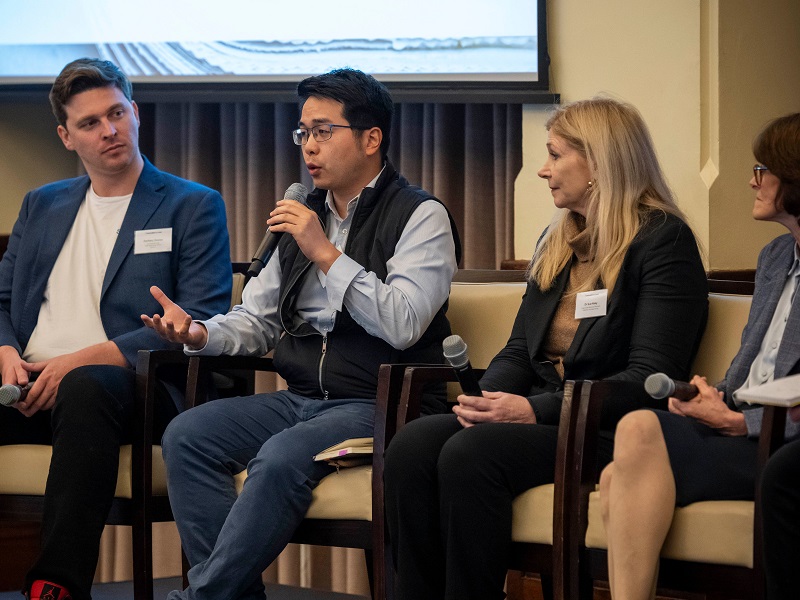A dearth of scaleup funding and workforce constraints are stifling Australia’s budding quantum sector, according to local deep tech founders, who say more venture capital and government support is needed.
That was the message driven home at the launch of InnovationAus.com’s Industry Papers on Wednesday, where a panel of some of the nation’s brightest minds discussed the systemic issues facing the ecosystem and startups more generally.
Australia chief scientist Cathy Foley is also a “bit worried” the nation will fall short of its quantum workforce needs, despite already having one of the largest quantum workforces in the world.

National science agency CSIRO has conservatively estimated that the quantum sector could generate 8,700 jobs by 2030, growing to 16,100 jobs by 2040 and 19,400 jobs 2045 as the sector takes off.
“If you do the sums, we need to build up the capability and the depth in the university to keep training. So getting the workforce balance right is a real focus at the moment, and work is being done on that, but it takes time,” Dr Foley said.
Australia has already begun to reap the benefits of its $1 billion investment in Californian startup PsiQuantum, according to Dr Foley. She gave only technical approval on the proposal, but says it has already generated a noticeable uptick in quantum jobs.
“I’ve been tracking those [job ads]. Australia had been limping along until now, but it has suddenly gone up since the PsiQuantum [investment] was announced,” she said on Wednesday.
Dr Foley’s workforce concerns are shared by Quantum Brilliance chief executive Mark Luo, who agreed there is “absolutely” a skills gap in the sector, which demands not only physicists, but people with a background in semiconductors and new materials.
“At Quantum Brilliance we’ve actually spent more time hiring people that are not traditional physicists into the company and engaging them in the workforce,” he told the audience.
Perhaps a greater barrier to success, however, is Australia’s “horrible” track record with growth funding, with startups across the board experiencing a significant drop off after Series A and Series B raises.
“The reality is, in Australia, you have a lot of seed stage funds, but then when you get past Series A and Series B, all the money disappears,” Mr Luo said, adding that Australia has “never really built its wealth in deep tech or manufacturing technology”.
“That venture capital gap… results in, basically, local companies getting acquired by companies in Switzerland or the United States at a very cheap valuation, and the job go overseas.”
For Robotics Australia Group chair Sue Keay this is exacerbated by the gradual sell-off of large specialist companies who could have otherwise been in a position to acquire and grow companies locally.
“We’ve built this fantastic kindergarten, where we’re raising lots of really clever companies that are doing great things. But then where are they going to graduate to?” she said.
Dr Foley said that bringing a “big quantum company” to Australia was front and centre of the federal government’s decision to invest in PsiQuantum. By building a quantum computer in Brisbane, the company and partners create volume for adjacent sectors, she said.
“We’re not doing our usual BAU of… being the world’s kindergarten for quantum [and allowing] all the other countries will come around and hoover up, like they did with Wi-Fi.”
“So, this is the government’s attempt to say let’s do different, and we may be able to have something here. And the nice thing with this one was it was a startup that is based on University of Queensland-developed IP.”
But companies involved in the research and manufacturing of semiconductors still face a difficult decision given the billions in subsidies on the table in other developed economies like the US.
“We’re an Australian company, and we want to be an Australia company, but it does make it tough,” said Zach Dowse, the chief operating office of Canberra-based 3D printing startup Syenta.
“There’s an old saying: you go where the money is, and we have to do that in order to survive. Its certainly our perspective that when… that direction is set, a company like ours will stay.”
Mr Luo said the role of government through investment vehicles like the $15 billion National Reconstruction Fund “is important, but it is not enough” and there “needs to be more”.
“If we really want to create the next Canva within deep tech or the next Atlassian, we’ve got to be much bolder as Australians and corporates. We need… more innovative board members and really change the mindset on venture capitalists in Australia.”
The Industry Papers is a big undertaking and would not be possible without the assistance of our valued sponsors.
InnovationAus.com would like to thank Geoscape Australia, The University of Sydney Faculty of Science, the Semiconductor Sector Service Bureau (S3B), AirTrunk, InnoFocus, ANDHealth, QIMR Berghofer, Advance Queensland and the Queensland Government.
You can purchase a copy of the papers here.
Do you know more? Contact James Riley via Email.

